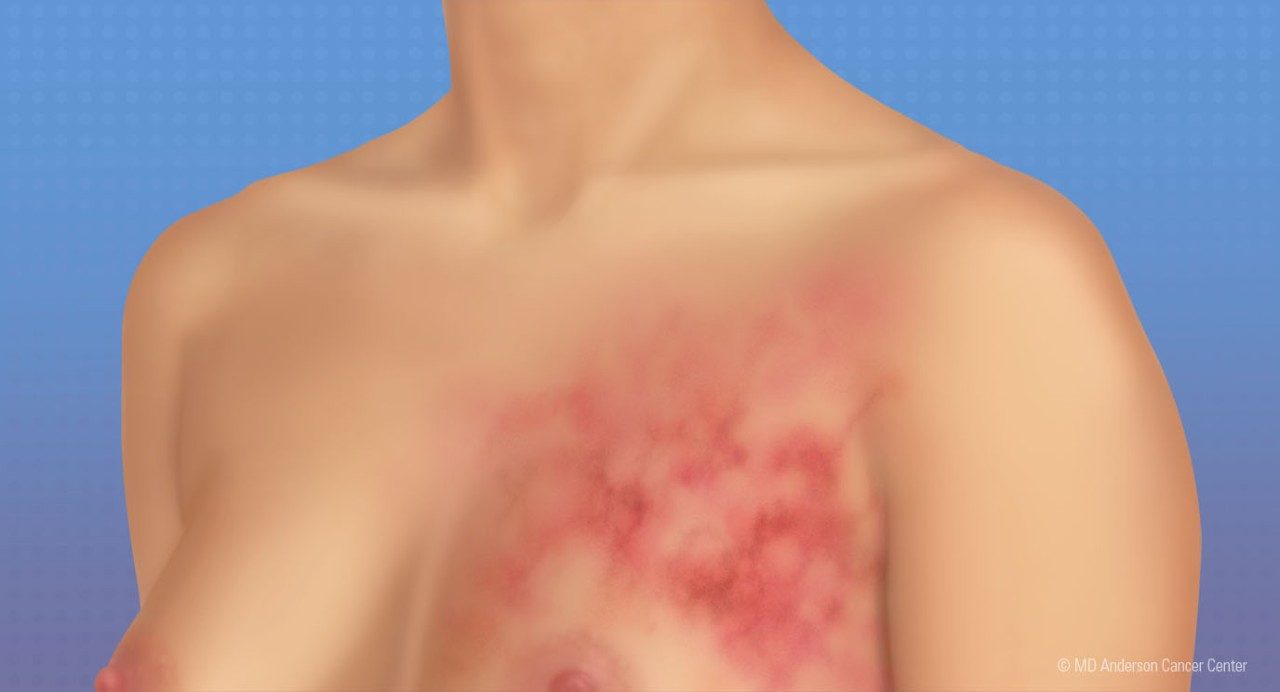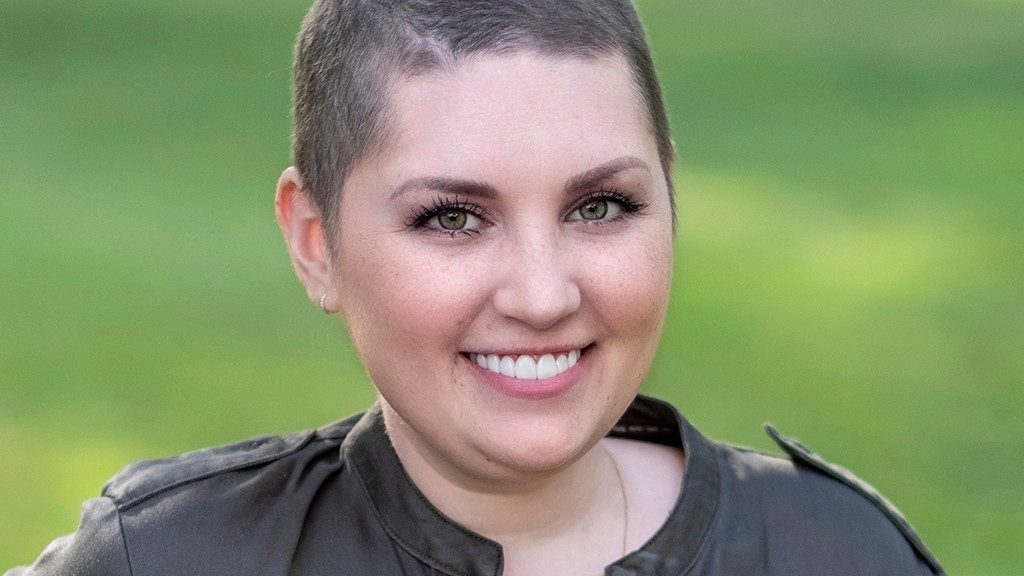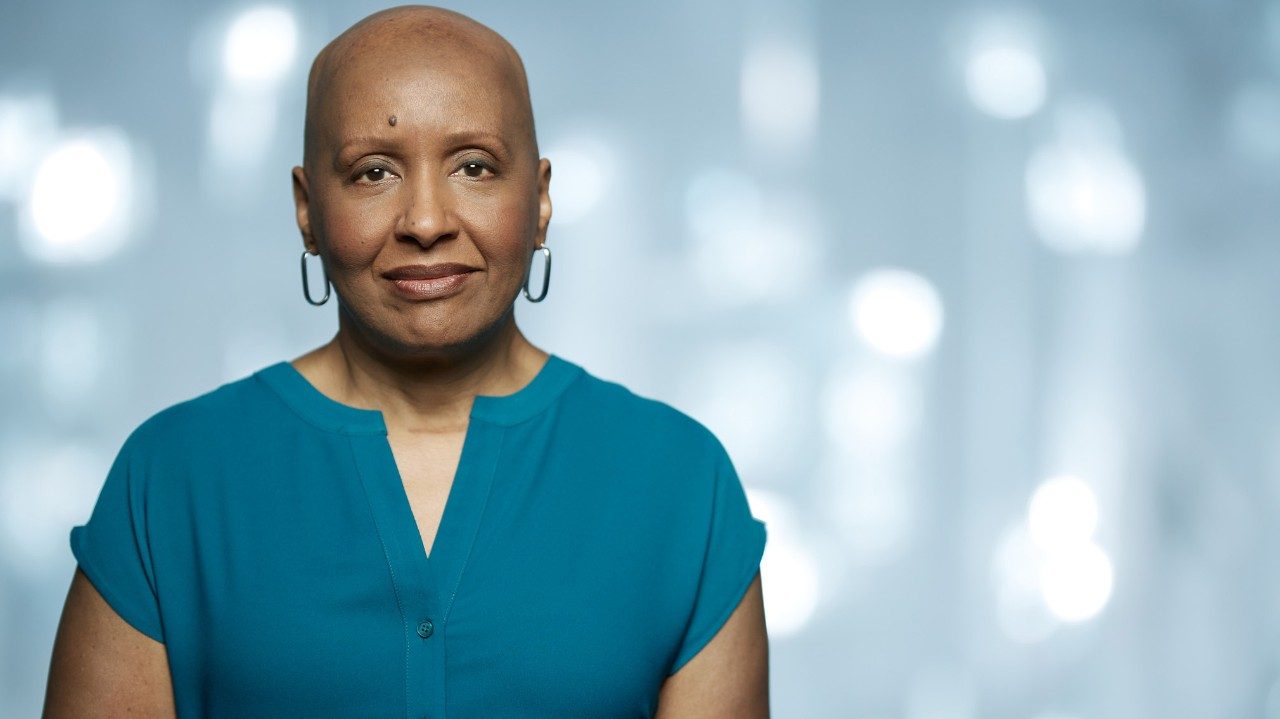Where you go first for breast cancer treatment matters. The subspecialists at MD Anderson provide personalized, safe, compassionate care from the start.
A Full Spectrum of Care
What does an early inflammatory breast cancer rash look like?
Redness or another change in the skin color of the breast, swelling on one side and/or a rash that appears quickly — sometimes literally overnight — are the hallmark symptoms of inflammatory breast cancer.
But what does that rash actually look like? And how can you distinguish it from other, more benign conditions?
To learn more, we went to Wendy Woodward, M.D., Ph.D., a radiation oncologist and researcher who specializes in the treatment of inflammatory breast cancer.
What does an inflammatory breast cancer rash look like?
That’s kind of hard to say, because not everyone’s rash looks the same. And, it doesn’t always look like a rash. Sometimes, you can just see the breast skin pores very clearly because they look exaggerated due to swelling. Or, there’s redness or some other type of discoloration of one breast.
The rash associated with inflammatory breast cancer can also vary in appearance based on someone’s skin tone. It may look dark or even purple on some women, rather than red. But there’s not a defining skin change that’s the same for everybody. And, no matter how early a rash is diagnosed as inflammatory breast cancer, it is always considered at least stage III.
What characteristics distinguish an inflammatory breast cancer rash from other kinds?
Speed is one factor. Inflammatory breast cancer is quite aggressive, and it can develop very, very quickly. So, if you notice a marked change in the size of your breast or in its color or texture over a few weeks — or even a few days or hours — you should get it evaluated right away.
In addition, though some women describe the rash as starting out small — or even resembling a bug bite — it often involves most of the breast within a very short time frame. So, a spreading rash deserves prompt attention, too.
Are there any other conditions that can cause rashes on the breast?
Yes. Mastitis is the top one. It’s fairly common during breastfeeding, so many people tend to assume that inflammatory breast cancer is just an infection. It gets mistaken for mastitis and abscesses a lot because most health care providers have never seen inflammatory breast cancer before. They tend to err on the side of the rash being caused by something more benign.
The number of people diagnosed with inflammatory breast cancer each year is incredibly small. It’s a drop in the bucket, compared to other types of breast cancer. And most people who notice changes in their breasts will not ultimately have breast cancer.
By the time patients get to MD Anderson’s specialized Inflammatory Breast Cancer Clinic, though, they’ve often already gone through multiple rounds of antibiotics with no improvement.
Have there been any advances in the diagnosis of inflammatory breast cancer, based on rashes?
Yes. We’re working on two different projects right now.
One is an update of the MD Anderson cancer algorithm to help patients obtain a faster diagnosis. If the changes they’ve noticed are enough to point to inflammatory breast cancer, they’ll be able to use this algorithm to back up their request for additional imaging or a breast biopsy.
That way, if a doctor says, “OK, here are some more antibiotics,” patients can say, “Wait. Shouldn’t we try to rule this out first?” and show them the MD Anderson algorithm. A lot of doctors think of a breast biopsy as a really big step. But in this case, it’s not. It’s just the right thing to do.
We’re also in the very early stages of developing of an app that would let patients take a picture of their own breast, upload it and use artificial intelligence to compare it to photos of both healthy breasts and those from patients with confirmed inflammatory breast cancer diagnoses. The hope is to give patients a gauge to determine whether their rash is something to be concerned about and doctors a tool to make a diagnosis right away.
Is there anything else people should know about inflammatory breast cancer rashes?
Yes. Sometimes, it can be hard to distinguish non-inflammatory breast cancer from inflammatory breast cancer, since both can cause redness of the breast and skin changes that might be missed.
But if you notice really rapid changes in one or both of your breasts, try to be seen by a doctor within two weeks. While a short course of antibiotics is not unreasonable when the suspicion of inflammatory breast cancer is low, don’t be afraid to ask for breast imaging or a biopsy if your symptoms don’t fully resolve in less than two weeks. If your condition gets better before the results come in, great. But if not, you’ll be that much closer to a diagnosis.
Request an appointment at MD Anderson online or by calling 1-877-632-6789.
Personalized triple-negative breast cancer treatment made me feel special
I didn’t have any breast cancer symptoms until early 2019. Then, a lump the size of a lime popped up on my right breast, seemingly overnight. I hadn’t been able to feel it before that because it was growing so deep below the surface.
I went to my OB/GYN the day after I discovered it. She immediately referred me to a breast surgeon, who ordered an ultrasound. A few days later, I had a biopsy, and the following week, I received my diagnosis: triple-negative invasive ductal carcinoma, a type of breast cancer.
Coming to MD Anderson for breast cancer treatment
I grew up in the Houston area, so once I was sure I had breast cancer, I was pretty determined to go to MD Anderson for my treatment. I knew it offered the best cancer care in the world, so to me, there wasn’t really another choice.
I had my first appointment a few weeks later. And after all my scans were done, I met with my entire team at once: oncologist Dr. Rashmi Murthy, surgeon Dr. Mediget Teshome and radiation oncologist Dr. Benjamin Smith.
First, they confirmed my diagnosis. Then, they laid out my treatment options, which included a Phase II clinical trial under Dr. Jennifer Litton. It involved a new drug, a type of targeted therapy that includes a PARP inhibitor.
The best part of MD Anderson: having a choice
My doctors recommended the clinical trial, but they also made it clear that the decision was mine. I really liked that they gave me a choice.
The first place I went was like, “This is your diagnosis and this is your treatment plan. You start next week.” But at MD Anderson, my doctors said, “OK. We can do this or this or this for you, but you get to choose.”
When you have cancer, it can feel like you have no control of your life anymore. So, this gave me a little bit of that control back. And I really appreciated it.
The best part of individualized treatment: feeling like I really mattered
I also appreciated how personalized my treatment was. Before coming to MD Anderson, I didn’t realize there were so many different types of cancer. I also didn’t know there were so many treatment options available.
I have a friend who received the exact same diagnosis as I did. She has the same type of cancer and joined the same clinical trial. But we still have different treatment plans. I think that’s pretty amazing.
I ended up joining the clinical trial, too. And I’m cancer-free today as a result. But it was comforting to know that I had other options, and could have chosen a different treatment option if I’d wanted to.
The way MD Anderson personalizes treatment made me feel like my case was special and that I really mattered. In the end, that’s all you can ask from anyone.
Request an appointment at MD Anderson online or by calling 1-877-632-6789.
Breast cancer survivor: Watch for changes in your breasts
In late 2016, I was eating organic food, working out regularly and had never missed a mammogram. Yet, I still ended up with a breast cancer diagnosis at age 50.
I felt a lump in my right breast one day and knew it wasn’t normal. So, I went to my primary care physician. She ordered a diagnostic mammogram, and a biopsy to confirm it. Then she referred me to a local oncologist.
Originally, I’m from Chicago, but I’ve lived in eight different cities since then. So, while I’d probably heard MD Anderson’s name in passing, I was completely unaware that it was the nation’s top-ranked hospital for cancer care. That’s why I didn’t even think of it when I was diagnosed on Dec. 27, even though I live just down the street.
Today, I am so glad that I landed there. Because I am fairly picky, and everyone on my team at MD Anderson was amazing. I don’t believe in flukes, so I attribute my guidance there to the hand of God.
Quick self-referral process swayed me
One of the things that astonished me most was how responsive everyone at MD Anderson was.
I learned that I had breast cancer at 3:30 on a Tuesday afternoon. I couldn’t eat or sleep that night, so I went online to do some research. Then, somebody in a cancer forum wrote, “You know, you live in Houston, so you might want to check out MD Anderson. It’s considered the best in the world.”
I went to the website and filled out MD Anderson’s online form in middle of night. And to my surprise, someone called me early the next morning. She said, “We got your application, but I have just a few more questions.” After I answered them, we hung up. A few hours later, she called me again. She said, “OK, we have a team mobilized, and an opening on Jan. 2. Can you be here?”
My breast cancer treatment
The rest, as they say, is history. At MD Anderson, a team of doctors including Dr. Nuhad Ibrahim recommended a mastectomy, followed by six months of chemotherapy. A tissue expander would be installed during the surgery and replaced with a permanent implant later on. The only good thing about my cancer was it had not spread to any lymph nodes, so Dr. Welela Tereffe said I wouldn’t need radiation therapy.
I had the mastectomy on Feb. 7, 2017, and my last dose of chemotherapy on Aug. 31, 2017. That was only days after Hurricane Harvey made landfall in Houston, and a lot of places in the city still had high water issues. I was one of the first patients let back into the hospital for treatment afterward. My permanent implant was installed on Nov. 2, 2017.
A cheerleader for breast self-awareness
I’ve been cancer-free now since Feb. 7, 2017. So my holiday season this past year was amazingly great compared to how it was three years earlier.
But the only reason I even knew I had cancer was because I noticed a change in my breast. Cancer doesn’t run in my family, and mine was fast-growing and aggressive. It was already sizable by the time I found it. That’s why I encourage other women to be on the lookout for changes, too. Cancer can show up even between your annual mammograms, so it’s important to know your breasts.
Request an appointment at MD Anderson online or by calling 1-877-632-6789.




